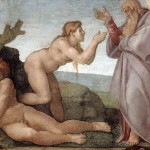In John 3:5, Jesus tells Nicodemus that to enter the kingdom one must be “born of water and the Spirit”. How is this phrase understood? Is it a single construct (i.e. one birth of both water and Spirit)? Or are two births in view (one of water and one of Spirit)? And what does it mean to be born of water?
Context is the key to interpretation. You’ve heard the mantra in real-estate, “location, location, location.” Well in interpretation its, “context, context, context.” The location of a verse matters in its interpretation.
Think of the word “hand,” for instance. What does it mean? Without context “hand” could have quite a few meanings.
- the hired hand fixed the railing
- his hand was illegible
- he wanted to try his hand at singing
- I didn’t hold a good hand all evening
- The hands read 3:25
- give the little lady a great big hand
- hand me the spoon, please
we can see the words meaning more clearly in context.
The Immediate Context
The phrase “born of water and Spirit” appears in Jesus’ night time conversation with Nicodimus. In John 3:3, Jesus says,
I tell you the truth, no one can see the Kingdom of God unless he is born again.
Nicodimus is dumbfounded
How can a man be born when he is old…surely he cannot enter a second time into his mother’s womb to be born!
Jesus then rephrases his earlier statement
I tell you the truth, no one can enter the kingdom of god unless he is born of water and the Spirit. Flesh gives birth to flesh, but the Spirit gives birth to spirit.
The contrast between flesh and spirit in the last verse would seem to indicate that water stands for natural birth.
Beyond the Chapter
But there’s an even broader context to John 3:5 that others pick up on. Two chapters earlier, in John 1:32-33, John the baptist testifies,
I saw the Spirit come down from heaven as a a dove and remain on him. I would not have known him, except that the one who sent me to baptize with water told me, “the man on whom you see the Spirit come down and remain is he who will baptize with the Holy Spirit.”
Here water and Spirit are linked in the Baptist’s ministry and testimony. John baptizes with water but Jesus baptizes with the Holy Spirit. If John 3:5 is linked to this verse, water could refer to baptism (or repentance which John’s baptism is often said to represent).
A Look to the Whole Book
But there’s still a greater context which defines the meaning of water. Water isn’t simply mentioned in these two scenes. It’s used everywhere in John as a metaphor and a symbol.
- John says three times that he baptizes in water (1:26, 31, 33)
- Jesus turns water into wine (2:1-10)
- Jesus says we must be born of water and the spirit (3:5)
- John baptizes at Aenon near Salim because “there was much water there.” (3:23)
- Jesus promises the woman by the well living water (4:4-28)
- The lame man wants to get healed in the troubled waters of Bethesda (5:7)
- Jesus walks on water (6:19)
- Jesus invites the thirsty to come to him and drink (7:37-39)
- Jesus heals blind man in pool of Siloam (9:6-7)
- Jesus washes his disciples feet (13:4-5)
- Water flows from Jesus’ side (19:34)
With the exception of John’s baptism and Jesus walk on water, these references do not appear in Matthew, Mark or Luke. They are entirely unique to John.
Each of these scenes plays a crucial role in revealing the water’s intended meaning. John develops this meaning early in his gospel, contrasting water that is used in ritual and tradition with a higher, heavenly water offered in Jesus.
John the Baptist’s Testimony (1:19-34): John says Jesus’ baptism in the Holy Spirit surpasses his baptism in water. Water here is the medium of a traditional ritual of purification. But Jesus’ in a comparative and a contrasting sense baptizes with the Holy Spirit (i.e water from above).
Jesus Wedding Miracle (2:1-11): Jesus’ “water-turned-wine” is better than the choice wine/water which came before. The water which becomes wine is drawn from containers used for ritual purification. Though Jesus could presumably have reused the empty wine jars, he instead has the servants fill six waterpots which John says were “set there for the Jewish custom of purification.” Jesus surpasses this ritual water by transforming it into wine (spirit water) which the headwaiter testifies surpasses the wine that came before.
Jesus Conversation by the Well (4:4-26): Jesus’ living water is greater than Jacob’s well. The well itself is a traditional site analogous to the Samaritan’s worship on the mountain. The woman points to the greatness of the well by pointing to “father” Jacob as the source and user of the water. The word “father” is again used when the topic of conversation moves from well to worship. Just as ‘father” Jacob gave the well, the Samaritan “fathers” had given them worship on the mountain. When Jesus offers the woman living water she responds by asking if he is “greater” than Jacob who gave them the well. Jesus indicates that it is by contrasting the limitations of the well water with the never-ending life-giving water he supplies. His water is “Spirit” like the true worship God seeks.
His Healing by the Pool of Bethesda (5:1-9): Jesus’ healing is greater than the troubled water in the pool of Bethesda. Once again the waters of Bethesda are linked with tradition. While the tradition mentioned in 5:3 may not be original to John, it appears to be in line with John’s repeated use of water. While the man looks to the traditional water to heal him, he is powerless to reach it. Because Jesus reaches the man at his need, His power is revealed to be greater than the stirred water’s of the pool.
Jesus’ Invitation to Drink (7:37-39): Jesus’ “living water” is greater than the feasts water ceremony. Jesus invitation occurs on the last day of the Feast of Tabernacles. On this day the High Priest poured water out in the temple as a symbol of the later day river that would flow from the temple (Ez. 47:1-12; Zech. 14:8). Jesus’ invitation and reference indicates that he is the scriptures true fulfillment. The water here is explicitly connected with the Holy Spirit (John 7:39).
The cumulative effect of these scenes indicates that there’s more than one meaning given to water. Sometimes water is simply a clear physical liquid used for washing, drinking etc. However when associated with Christ, water signifies the Spirit (i.e. “living-water or water from above).
A contrast between two waters (higher and lower) fits within John’s narrative’s dualism. Many of John’s metaphors and symbols have natural polarity. For instance John employees the imagery of light and darkness, life and death, above and below, true and false. Each refers to a separation between tangible world in which we live and the intangible realm of the Spirit. Because it’s immaterial, the world “above” is separate from the world “below.” For instance in John 3:12, Christ distinguishes between “earthly things” and “heavenly things” and in 8:23 He separates Himself from His opponents, stating, “You are from below I am from above; you are of this world, I am not of this world.” The higher world represents an intangible reality which man cannot perceive. The prologue asserts “No one has seen God at any time” (1:18). Yet, it also goes on to equally claim that Jesus’ physical presence “explained” or “made known” the invisible God (1:14, 18).
Through metaphors and symbols, John constructs a ladder of understanding from the lower physical world to the higher world of the Spirit. A symbol, according to ordinary sense, is “that which represents something else by virtue of an analogical relationship.” H. Levin describes it simply as “a connecting link between two different spheres.” The symbol, “points beyond itself”, and in someway “embodies that which it represents.” Thus, John takes tangible images and infuses them with a higher connotation in order to define the imperceptible world of God.
Water function within this dualism.
Reading John 3:5 in light of its context
Returning to John 3:5 we can see how this repeated contrast between two different waters fits into the phrase “born of water and the Spirit.”
Most interpretations hold that water and Spirit exist as two distinct elements in the process of rebirth. The English word “and” implies two distinct things. This would certainly fit the apparent contrast between the lower water and the Spirit (higher water) in the scenes outlined above. But these scenes also make a comparison between water and Spirit and unlike the English translation, the Greek may suggest that water and Spirit are one thing and not two. C.H. Talbert states,
The construction in Greek is that of two terms joined by “and” (kai) and governed by one preposition. This Greek construction normally points to one act: e.g., Titus 3:5. If two acts were involved, normally two prepositions would occur.
Though Talbert appears confident in this translation, J. Ramsey Michaels counters with a more moderate approach. He states,
The fact that both are governed by a single preposition in Greek suggests that they are one. Yet in 1 John 5:6, the same sort of construction is immediately followed by a singling out of each element with its own preposition and definite article. The decision must therefore be made on other than grammatical grounds.
Given room to maneuver, immediate context points to water symbolizing the Spirit. “Born of water and Spirit” occurs as a reiteration of John 3:3’s phrase “born again”. The word, “again” possess two meanings. Though Nicodemus translates the word as “a second time,” the word also means “from above.” It is this later interpretation, which Jesus seems to intend. Thus Jesus, in John 3:3 and 3:5, speaks of one birth from above. According to the freedom granted by both grammar and context, Jesus tells Nicodemus that he must be “born of water from above, which is the Holy Spirit.”

















